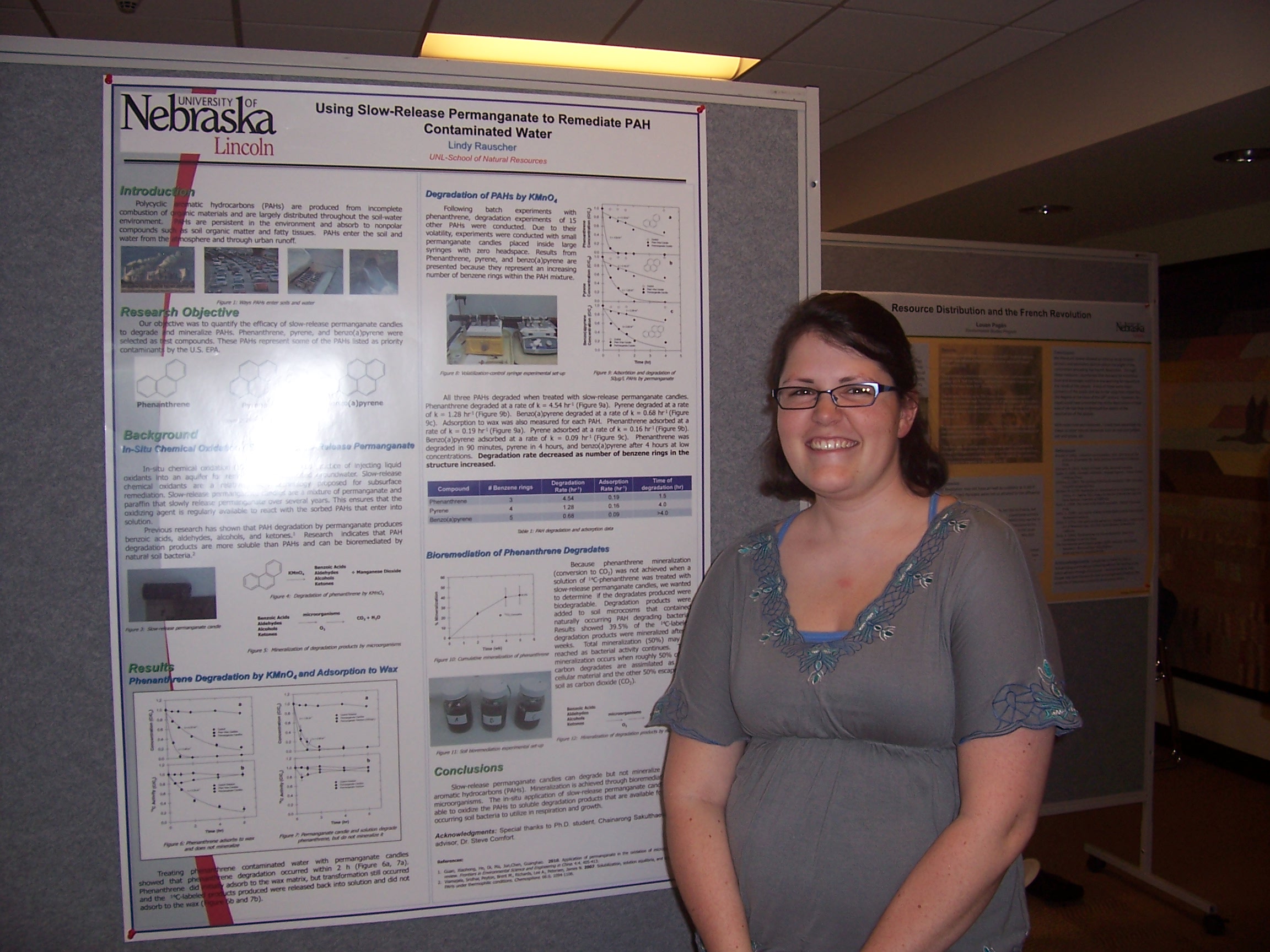
Congratulations to Lindy Rauscher, an environmental restoration science major, whose poster, “Using slow-release permanganate to remediate PAH-contaminated water,” was named the College of Agricultural Sciences and Natural Resources’ best poster presentation at UNL’s Spring Research Fair 2012.
Lindy, who graduated in May, worked as a UCARE student with Steve Comfort, an environmental chemist in the School of Natural Resources. Along with recognition of her efforts, the award included a $250 voucher to the university bookstore.
PAHs -- Polycyclic Aromatic Hydrocorbons -- are hazardous chemicals released into the environment by burning organic matter such as coal and other fossil fuels, Lindy explained. PAHs are released into the air, settle in water and soil, or end up in urban runoff and contaminate surface water. Eventually, PAHs can end up in fatty tissues in fish and humans.
Lindy conducted her research in Comfort’s laboratory, refining techniques to develop slow-release oxidants to treat the PAHs. She worked with three specific PAHs representing different molecular structures, including benzo[a]pyrene, and learned that getting rid of them is a two-step process, involving first chemical degradation and then bioremediation. She also learned that the larger PAH molecules take more time to degrade.
“Sharing this relationship will help other scientists better design their remediation techniques,” she said. “I focused on three PAHs. [Outside the lab,] they don’t exist individually. They’re all mixed together.”
Because PAHs are non-polar and hydrophobic, they are not available as nutrients to bacteria in soil, she said. But treating the PAHs with permanganate changes the chemical properties so that bacteria can do the cleanup work.
Lindy mixed permanganate with paraffin to create a purple cylinder of wax that gradually turned white when it was immersed in contaminated water and the permanganate was released by osmosis and spread by diffusion. Once the PAH reacts with the permanganate, soil bacteria can use it as a food source, Lindy said. Bacteria convert it to carbon dioxide and water in a process known as mineralization.
Lindy, who is from Lincoln, knew when she started at UNL that she was interested in remediation of toxic chemicals and hazardous materials. Lindy first got a summer job working in Comfort’s lab, and then applied for UCARE support to do a research project with the same group. The UCARE – Undergraduate Creative Activities and Research Experiences – Program, funded by the Pepsi Endowment, provides funding for undergraduates to work with faculty on research.
“The advantage of doing a UCARE project is getting to work closely with faculty and doctoral students to purse something beyond your normal classes,” she said. “I was working with doctoral students and Dr. Comfort on a daily basis.”
She was mentored by one of Comfort’s Ph.D. students, Chainarong “Tiger” Sakulthaew. “Tiger was the one who helped me most directly research chemicals, design experiments, and carry out experiments,” Lindy said. “He was always very willing to help.”
In addition to her studies as part of the Honors Program, Lindy found time for activities such as playing percussion in marching band, being in the Soil and Water Resources Club and on the Soil Judging Team, and promoting RecycleMania, and she spent the first semester of her senior year at the University of Edinburgh in Scotland.
Next fall Lindy plans to study environmental law, either at UNL or at the University of Oregon.
“I’m interested in the environmental problems of the Midwest,” Lindy said. “Agriculture, water, hazardous waste … “
Besides choosing between law schools this summer, Lindy anticipates working with Comfort and Sakulthaew to turn her research into a publishable paper.